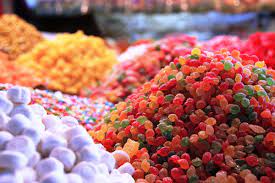
Food dyes Red #40, Yellow #5 and #6, and Blue #1 are chemicals that most Americans feed their children on a daily basis. They make food look pretty but how certain are we that they are safe?
True, the FDA has concluded, based
on long-term animal studies, that these dyes “do not pose significant health
risks.” The amount that is “safe” for children has still not
been ascertained. And the fact that some dyes have been found to produce
tumor growth in animals while others contain small amounts of benzene, a known
carcinogen, has not yet shaken the FDA from its conclusion about their
“probable safety.”[1]
Not all countries are as sanguine
as the U.S. about health effects of dyes on children. The UK has banned Red #40,
Yellow #5 and #6, Blue #1[2]
due to British studies linking these dyes to hyperactivity, ADHD, and other
behavioral changes in children. Some European countries say there is enough
evidence to ban artificial food dyes altogether.
Overall, Europe is more
conservative about allowing additives and hormones into foods than is the U.S.
The EU considers “possibility,” while US regulators consider “probability.”
Another difference between the U.S. and Europe is that the U.S. has a strong
food lobby that helps shape regulations and policy. The U.S. also does not have
a system in place for reevaluating chemicals once they are approved as the EU
has.[3] (Everyday
Health 7/20/21)
Food dyes are not a new
phenomenon. The first artificial food colorings were created in 1856 at the
height of the Industrial Revolution, when foods began to be mass produced for a
growing middle class. Manufacturers sought new ways to improve the look of
food to appeal to consumers. Many of the dyes made over the years were
considered toxic – the original ones were made from coal tar – and removed from
food supply. Current dyes are made from petroleum.
What is new is how ubiquitous dyes
are; they are in everything from candy and flavored yogurt to salad dressing
and vitamins. And when it comes to food marketed to children, the colors
abound. Just check out the cereal aisle. Children are a major consumer
demographic, and bright colors are key to appealing to kids.
New concerns have emerged
regarding dyes. In April 2021, the California EPA’s Office of
Environmental Health Hazard Assessment reported that the “current federal
guidelines for safe levels of intake of synthetic food dyes may not be
enough to protect children…as they are based on 35- to 70-year-old
studies.” Also in 2021, the American Academy of Pediatrics recommended
the elimination of
artificial dyes in children’s diets due to “their role in child behavior and
exacerbating ADHD.”[4]
(Everyday Health 7/22/21 B. Upham. Medically reviewed by Justin Laube, MD). And
Julia Sumpano, Registered Dietician at the Cleveland Clinic, says reducing the
use of artificial dyes is even more important for those with a cancer risk in
their family.
Here are some facts to ponder:
·
Artificial food dye
consumption has increased by 500% in the last 50 years.
·
American children are the
greatest consumers of dyes, presumably because we have the largest variety of
products targeted at children.
·
Children ages two to five
consume dyes in larger doses than adults in proportion to body
weight.
·
Yellow #5, also known as
tartrazine, is found in drugs, makeup, processed veggies, and beverages. It can
cause itching, hives, or asthma symptoms. (www.fda.gov)
·
Titanium dioxide, a
chemical used to give certain candies their bright colors (Skittles, Starburst)
was found to build up in the body and damage DNA, (No surprise, it is banned in
Europe.)
The FDA continues to allow food
ingredients that manufacturers designate as GRAS – generally regarded as safe –
despite the lack of FDA testing. That has long been cause for concern. Children
are exposed to multiple dyes in a day, many more than a generation ago. Some
children may be more sensitive than others to artificial dyes, especially in
combination with the many chemicals already in our food supply and environment.
Given the uncertainty about the impact these chemicals have on our children’s
health, shouldn’t we be more cautious about their consumption?
Having grown up with a mother trained in nutrition at Cornell
University, Jill enjoys making and eating healthful foods which she shares with
her grandchildren. Recipes available upon request: 410-262-3168.






